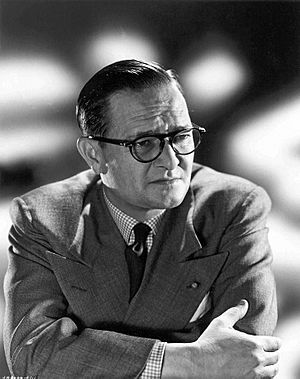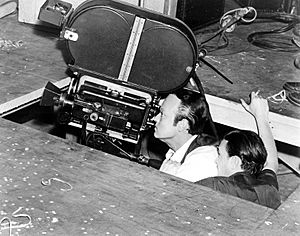Gregg Toland facts for kids
Quick facts for kids
Gregg Toland
|
|
|---|---|

Gregg Toland in 1947
|
|
| Born |
Gregg Wesley Toland
May 29, 1904 Charleston, Illinois, U.S.
|
| Died | September 28, 1948 (aged 44) Los Angeles, California, U.S.
|
| Occupation | Cinematographer |
| Years active | 1926–1948 |
| Known for | Innovative use of lighting and techniques such as deep focus |
|
Notable work
|
Citizen Kane The Best Years of Our Lives The Grapes of Wrath The Long Voyage Home Wuthering Heights |
| Spouse(s) |
Helen Barclay
(m. 1934; div. 1945)Virginia Thorpe
(m. 1945) |
| Children | 3 |
Gregg Wesley Toland (May 29, 1904 – September 28, 1948) was an American cinematographer. A cinematographer is the person in charge of how a movie is filmed. They decide on the lighting, camera angles, and how the picture looks.
Toland was famous for using new techniques. One special technique he used was called deep focus. This means that everything in the picture, from things very close to the camera to things far away, looks clear and sharp. You can see his amazing work in movies like Citizen Kane (1941), The Best Years of Our Lives (1946), and The Grapes of Wrath (1940).
He was nominated for six Academy Awards for Best Cinematography. He won an Oscar for his work on Wuthering Heights (1939). In 2003, he was named one of the top 10 most important cinematographers ever.
Contents
Gregg Toland's Early Life and Career
Gregg Toland was born in Charleston, Illinois, on May 29, 1904. His parents divorced when he was young. His mother moved to California.
Toland started working in movies when he was just 15 years old. He began as an office boy at Fox studio. A year later, he became an assistant cameraman.
He developed his unique lighting style by accident. While filming a short movie in 1928, one of his two main lights broke. He had to use only one light, which created a special side-lit look. This style became his trademark.
By the 1930s, Toland was the youngest cameraman in Hollywood. He quickly became one of the most popular cinematographers. Between 1936 and 1942, he was nominated for an Academy Award five times. He worked with many famous directors, including John Ford and Orson Welles.
Toland was always trying to improve his techniques. He worked on a special lens that could make objects both near and far look perfectly clear. He died in his sleep in Los Angeles, California, on September 28, 1948, at age 44.
Working on Citizen Kane
Many people think Citizen Kane has amazing visuals because of Toland's work. Some say his ideas were key to the movie's look. However, other experts believe the visual style came mostly from the director, Orson Welles.
Welles himself called Toland "the greatest cameraman who ever lived." He said Toland was a huge help to him as a young director. Toland would even secretly advise Welles on camera placement and lighting. This helped Welles look good in front of the experienced film crew.
The movie's visuals were a true team effort. Toland used his technical skills to help Welles achieve his vision.
New Camera Techniques
Toland's ideas changed how movies were filmed. Before him, cinematographers often used a shallow focus. This meant only one part of the picture was clear, like the person speaking. The background or foreground would be blurry. This helped guide the viewer's eye.
Toland's method was different. He used shadows and light to create depth. This made everything in the picture look clear, from front to back. He believed this was more like how our eyes see in real life. Our eyes blur what we are not looking at, not just what is far away.
For The Long Voyage Home (1940), Toland used a technique called back-projection. This helped him create his deep focus shots. He kept working on these technologies for Citizen Kane.
Deep Focus and Lighting
Toland made many changes to achieve deep focus in Citizen Kane. He worked with the set designer, Perry Ferguson. They used special ceilings made of fabric so microphones could be placed closer to the actors. This also allowed the camera to shoot from low angles without showing the real ceiling.
To get deep focus, Toland had to use a smaller camera opening, called an aperture. This meant he needed much brighter lights. He also used special lenses that let in more light. He worked with engineers to design his own cameras and lenses. His lenses had a special coating to reduce glare and improve light.
He also used a new, very fast film called Kodak Super XX. This film allowed him to capture clear images even with less light. Toland used very powerful Carbon Arc lights. These lights, combined with the faster film, allowed him to use smaller apertures than ever before.
Special Effects and Composites
Gregg Toland also worked with special effects expert Linwood G. Dunn. They created some shots that looked like deep focus but were actually two different shots put together. This is called a composite shot.
Some of these were made using an optical printer. This machine combined different film negatives. Toland didn't like this method much because it could lower the picture quality.
So, other shots were made as "in-camera composites." This means the film was exposed twice in the camera. For example, a glass in the foreground and a person in the background could both be clear.
Citizen Kane and The Long Voyage Home
Toland had already used many of these techniques in John Ford's The Long Voyage Home. Both movies share some interesting similarities:
- Distorted Faces: Sometimes, lenses were used to slightly distort faces in close-up shots.
- Floor Lighting: Sets were often lit from the floor instead of from above. This was new for Hollywood. It took longer but made the lighting look more natural and soft.
- Shared Credit: Both Orson Welles and John Ford gave Toland a special credit. His name as cinematographer appeared on screen at the same time as the director's name. This was a rare and generous tribute to his talent.
Welles greatly admired Toland. He said Toland was "the greatest gift any director... could ever, ever have."
Other Important Movies
While Citizen Kane is very famous, Toland's style was quite varied.
- For The Grapes of Wrath (1940), he made the film look very real and gritty. He was inspired by the photographs of Dorothea Lange.
- He also worked on Song of the South (1946) for Disney. This movie combined animation with live action using bright Technicolor film.
- In The Best Years of Our Lives (1946), his deep focus helped show all the details of the characters' lives.
Service During World War II
During World War II, Gregg Toland joined the U.S. Navy. He worked in the Navy's camera department. This led to his only work as a director. He co-directed December 7th: The Movie (1943) with John Ford.
This documentary was about the attack on Pearl Harbor. It was so realistic that many people thought it was actual attack footage. The film won an Academy Award for Best Documentary (Short Subject).
Awards and Nominations
| Year | Category | Film | Result |
|---|---|---|---|
| 1935 | Best Cinematography | Les Misérables | Nominated |
| 1937 | Best Cinematography | Dead End | Nominated |
| 1939 | Best Cinematography, Black-and-White | Wuthering Heights | Won |
| Intermezzo: A Love Story | Nominated | ||
| 1940 | The Long Voyage Home | Nominated | |
| 1941 | Citizen Kane | Nominated | |
| 1943 | Documentary Short Subject | December 7th: The Movie | Won |
Legacy
Gregg Toland is remembered as one of the most important cinematographers in film history. In 2003, the International Cinematographers Guild ranked him among the top ten most influential. Many modern cinematographers say he greatly influenced their work.
Images for kids
-
The final ending title card for Citizen Kane, showing Toland's name next to Orson Welles's.
See also
 In Spanish: Gregg Toland para niños
In Spanish: Gregg Toland para niños



